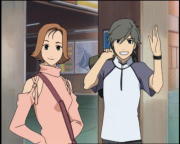
RahXephon Introduction
Ayato Kamina is a normal teenager living in Tokyo - he goes to school,
misses his mother who works a lot and either sketches or paints pictures
when he gets a chance. Indeed he has just finished one painting of
a girl in a yellow dress standing on a rocky promontory looking
out at a confusion of geometric shapes as the series starts. Rushing to
school it quietly becomes clear that while Ayato and his friends, whom
he meets on the train to school, seem normal enough but that things are
decidedly off.
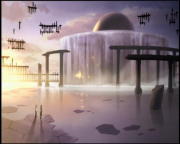 It might be the headlines on the train talking of how invaders
attacked leaving Tokyo by itself, or the strange fighter planes
now dogfighting in the skies, the men in black suits with blue
blood following him or the giant egg suspended in water inside a
stone temple that he is led to by a girl who bears a striking
resemblence to the one in his painting. Probably it is the giant
floating weapons that sing to defeat their enemies. Whatever it is
Ayato's world just isn't quite the world we know but it is
strangely familiar. By episode three the series opens up to show
us that the rabbit hole is going fairly deep and Ayato discovers
that he quite possibly may know absolutely nothing about what is
really going on...
It might be the headlines on the train talking of how invaders
attacked leaving Tokyo by itself, or the strange fighter planes
now dogfighting in the skies, the men in black suits with blue
blood following him or the giant egg suspended in water inside a
stone temple that he is led to by a girl who bears a striking
resemblence to the one in his painting. Probably it is the giant
floating weapons that sing to defeat their enemies. Whatever it is
Ayato's world just isn't quite the world we know but it is
strangely familiar. By episode three the series opens up to show
us that the rabbit hole is going fairly deep and Ayato discovers
that he quite possibly may know absolutely nothing about what is
really going on...
In a nutshell RahXephon is the telling of Ayato's journey to discover
precisely what is going on and what his place is in it all as the pilot
of the RahXephon itself. But what is the RahXephon for? Why has Tokyo
been isolated and spared from the crushing attack the rest of the world
has suffered? Not to mention why does the RahXephon itself, the floating
city that appears over Tokyo Bay briefly and the other floating
mecha called Dolems all seem so tantilisingly familiar? RahXephon
asks several questions like this and almost immediately begins
answering a few while also raising new ones as it answers the old ones.
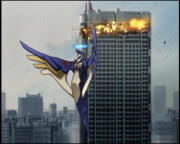 But such a simplistic breakdown of the series does it little to no
justice. While Ayato's journey is the core of the series there is a rich
diversity of backstory and secondary characters who all have fairly well
developed histories, personalities and story arcs of their own. As a
result while being a mecha show with the core staples that genre features
(namely large robots being piloted by teenagers who proceed to destroy
things in ever increasing numbers and inventive ways) RahXephon stands
out by being an epic character drama where the mecha are important but
take a back seat to the people piloting them and those around the pilots
who are supporting or manipulating them - depending on your perspective.
But such a simplistic breakdown of the series does it little to no
justice. While Ayato's journey is the core of the series there is a rich
diversity of backstory and secondary characters who all have fairly well
developed histories, personalities and story arcs of their own. As a
result while being a mecha show with the core staples that genre features
(namely large robots being piloted by teenagers who proceed to destroy
things in ever increasing numbers and inventive ways) RahXephon stands
out by being an epic character drama where the mecha are important but
take a back seat to the people piloting them and those around the pilots
who are supporting or manipulating them - depending on your perspective.
This character driven focus seems to inevitably invite comparison
between RahXephon and Neon Genesis Evangelion. Something that while
superficially tempting does both series an injustice. Neon Genesis
Evangelion is an intensely psychological series that used religious
imagery to try and question the fundamentals of life. RahXephon does not
have such lofty goals and while it does have a great deal of
psychological exploration it's primary aim is to tell a love story set
against a sweeping war. RahXephon as a result plays fairer with the
viewer and relies less on quite such intensely neurotic central
characters. It simply wants to tell you, in classic science fiction
tradition, a grand story about what if. What if history was a little
more complicated than ever we had understood?
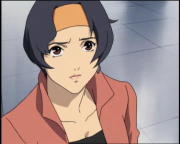 Tieing into actual history RahXephon carefully explores the thought
that maybe a certain little noted British author who published a barely
remarked on book early in the 20th century was actually right. Care and
attention to detail has been spent making this linkage throughout the
series. It is one of the hallmarks of the series that a great deal of
attention to detail has been spent allowing for casual comments to be
made in, say, episode two that don't fully pay off till series end. Or
the outstanding use of visual imagery and symbology to give you strong
clues so that those paying attention can often predict plot points that
are coming. This detail work means the series plays fair with the viewer
the whole way through obeying Chekov's rules for scriptwriting - the gun
is very definitely laid on the table in Act I Scene I so that no unfair
surprises are pulled. All the same the series is deftly written so that
it misdirects enough that you often are surprised anyway.
Tieing into actual history RahXephon carefully explores the thought
that maybe a certain little noted British author who published a barely
remarked on book early in the 20th century was actually right. Care and
attention to detail has been spent making this linkage throughout the
series. It is one of the hallmarks of the series that a great deal of
attention to detail has been spent allowing for casual comments to be
made in, say, episode two that don't fully pay off till series end. Or
the outstanding use of visual imagery and symbology to give you strong
clues so that those paying attention can often predict plot points that
are coming. This detail work means the series plays fair with the viewer
the whole way through obeying Chekov's rules for scriptwriting - the gun
is very definitely laid on the table in Act I Scene I so that no unfair
surprises are pulled. All the same the series is deftly written so that
it misdirects enough that you often are surprised anyway.
One of the pleasures of watching the series is spending time pondering
an episode and trying to predict where the story is going. It is
especially gratifying when you get a significant point revealed only to
go back and marvel at how you missed the often easy to spot
foreshadowing. Series' that pull off fairly misdirecting the viewer are
rare animals indeed and RahXephon is special on this count alone. It
helps that RahXephon also has very entertaining characters who while
flawed are usually only mildly so and mostly are good people. A quite
impressive feat is that even one of the more difficult to like
characters, Motoko Isshiki, has time spent that elevate him to an
almost tragic figure - one who just happens to still be a bit of
bastard.
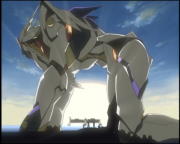 For a first time directorial effort by Yutaka Izubuchi (who
previously worked on Gasaraki as mechanical designer) the series
is simply amazing. With strong art work and such dense but not
distractingly complicated plotting he seems to have marshalled the
animation team to produce an exceptional piece of work. The
feeling engendered when episode twenty six ends is akin to that of
finishing a particularly good book. Sure there are questions left
over that it would be nice to answer further but they aren't
important ones. Mostly you just have the hankering that it would
be nice to spend a little more time with the characters to see
where they go next.
For a first time directorial effort by Yutaka Izubuchi (who
previously worked on Gasaraki as mechanical designer) the series
is simply amazing. With strong art work and such dense but not
distractingly complicated plotting he seems to have marshalled the
animation team to produce an exceptional piece of work. The
feeling engendered when episode twenty six ends is akin to that of
finishing a particularly good book. Sure there are questions left
over that it would be nice to answer further but they aren't
important ones. Mostly you just have the hankering that it would
be nice to spend a little more time with the characters to see
where they go next.
While the series itself is 4:3 formatted, it would have been
interesting to see what the team could have done with a 16:9 canvas to
work with, this doesn't slow the visual impact down with a variety of
quite beautiful scenes featuring - usually several exceptional ones per
episode. With it's strong almost primary colour toning there is a crisp
boldness to the imagery such that when the series mutes the colour
palette it is a very obvious stylistic touch that lends gravitas to the
events unfolding. This has been encoded onto DVD with a solid transfer
that lets the gorgeous colouring come through.
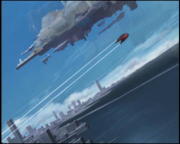 Musicly Ichiko Hashimoto provides us with a score that ranges from
delicate piano or flute pieces to jazzy tunes up to more strident and
modern instrumental work for action sequences. The music is a strong
component of the series, so much so that one particular scene which
consistants of two slow pans over still characters is remarkably tense
and exciting thanks purely to the score accompanying it. Yoko Kanno
lends her talents to the title theme, sung by Maya Sakamoto, which while
it isn't one of Yoko's best efforts is still a very catchy piece. One of
the standout pieces is the ending theme which captures the right note of
dreamy wistfulness.
Musicly Ichiko Hashimoto provides us with a score that ranges from
delicate piano or flute pieces to jazzy tunes up to more strident and
modern instrumental work for action sequences. The music is a strong
component of the series, so much so that one particular scene which
consistants of two slow pans over still characters is remarkably tense
and exciting thanks purely to the score accompanying it. Yoko Kanno
lends her talents to the title theme, sung by Maya Sakamoto, which while
it isn't one of Yoko's best efforts is still a very catchy piece. One of
the standout pieces is the ending theme which captures the right note of
dreamy wistfulness.
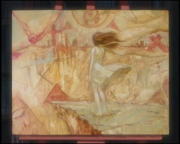 This leaves the vocal work and again it is very strong in both the
English and Japanese dub. ADV have done a wonderful job with both a
smart translation as well as good interpretive casting of the vocal
artists giving the series a very strong English dub. Mixed in 5.1 sound
a lot of care has been lavished on it. While sub purists may well be
upset that the character voice styles are different between the English
and Japanese dub the key plot points are preserved. It makes only minor
difference to listen in either language and certainly the 5.1 mix allows
the musical score a good deal of room to breathe.
This leaves the vocal work and again it is very strong in both the
English and Japanese dub. ADV have done a wonderful job with both a
smart translation as well as good interpretive casting of the vocal
artists giving the series a very strong English dub. Mixed in 5.1 sound
a lot of care has been lavished on it. While sub purists may well be
upset that the character voice styles are different between the English
and Japanese dub the key plot points are preserved. It makes only minor
difference to listen in either language and certainly the 5.1 mix allows
the musical score a good deal of room to breathe.
Rounding out the seven disc package is a healthy dose of
extras. Each disc comes with a booklet featuring production
sketches and artwork along with interviews with a variety of the
animation staff who worked on the series. Along with the, now
fairly standard, creditless opening and ending sequence each disc
has an animated display of production sketches relating to the
episodes on the disc set to an alternate version of the opening
theme. A variety of other extras complete the set with interviews
with the English dub cast as well as interviews with a variety of
the Japanese production staff. It is a solid set of extras that
helps to compensate for the slightly stretched out seven disc
release which is a 5/4/3/4/3/4/3 format.
All in all if you want a mecha series that never loses sight of the
people driving the technology whilst also telling a story in classic
science fiction terms then RahXephon fits the bill. In many ways the
series can be favourably compared to Cowboy Bebop - it gets in, tells a
good story with fun characters and then winds up in such a way that a
good conclusion has been reached. There is also a
movie now that adds to the series but
it is a little unusual in that it tells an alternate and quite
different retake on the series as a whole.
Click on a cover image to go to a full detail listing for each disc.
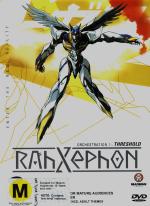
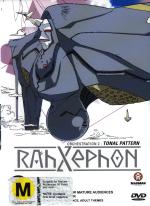
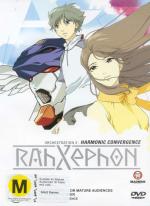
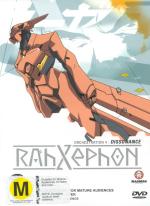
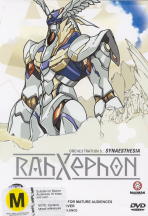
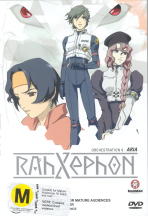
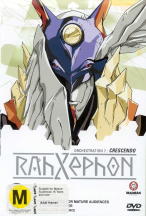
Philip R. Banks
Send Email
 It might be the headlines on the train talking of how invaders
attacked leaving Tokyo by itself, or the strange fighter planes
now dogfighting in the skies, the men in black suits with blue
blood following him or the giant egg suspended in water inside a
stone temple that he is led to by a girl who bears a striking
resemblence to the one in his painting. Probably it is the giant
floating weapons that sing to defeat their enemies. Whatever it is
Ayato's world just isn't quite the world we know but it is
strangely familiar. By episode three the series opens up to show
us that the rabbit hole is going fairly deep and Ayato discovers
that he quite possibly may know absolutely nothing about what is
really going on...
It might be the headlines on the train talking of how invaders
attacked leaving Tokyo by itself, or the strange fighter planes
now dogfighting in the skies, the men in black suits with blue
blood following him or the giant egg suspended in water inside a
stone temple that he is led to by a girl who bears a striking
resemblence to the one in his painting. Probably it is the giant
floating weapons that sing to defeat their enemies. Whatever it is
Ayato's world just isn't quite the world we know but it is
strangely familiar. By episode three the series opens up to show
us that the rabbit hole is going fairly deep and Ayato discovers
that he quite possibly may know absolutely nothing about what is
really going on...

 But such a simplistic breakdown of the series does it little to no
justice. While Ayato's journey is the core of the series there is a rich
diversity of backstory and secondary characters who all have fairly well
developed histories, personalities and story arcs of their own. As a
result while being a mecha show with the core staples that genre features
(namely large robots being piloted by teenagers who proceed to destroy
things in ever increasing numbers and inventive ways) RahXephon stands
out by being an epic character drama where the mecha are important but
take a back seat to the people piloting them and those around the pilots
who are supporting or manipulating them - depending on your perspective.
But such a simplistic breakdown of the series does it little to no
justice. While Ayato's journey is the core of the series there is a rich
diversity of backstory and secondary characters who all have fairly well
developed histories, personalities and story arcs of their own. As a
result while being a mecha show with the core staples that genre features
(namely large robots being piloted by teenagers who proceed to destroy
things in ever increasing numbers and inventive ways) RahXephon stands
out by being an epic character drama where the mecha are important but
take a back seat to the people piloting them and those around the pilots
who are supporting or manipulating them - depending on your perspective.
 Tieing into actual history RahXephon carefully explores the thought
that maybe a certain little noted British author who published a barely
remarked on book early in the 20th century was actually right. Care and
attention to detail has been spent making this linkage throughout the
series. It is one of the hallmarks of the series that a great deal of
attention to detail has been spent allowing for casual comments to be
made in, say, episode two that don't fully pay off till series end. Or
the outstanding use of visual imagery and symbology to give you strong
clues so that those paying attention can often predict plot points that
are coming. This detail work means the series plays fair with the viewer
the whole way through obeying Chekov's rules for scriptwriting - the gun
is very definitely laid on the table in Act I Scene I so that no unfair
surprises are pulled. All the same the series is deftly written so that
it misdirects enough that you often are surprised anyway.
Tieing into actual history RahXephon carefully explores the thought
that maybe a certain little noted British author who published a barely
remarked on book early in the 20th century was actually right. Care and
attention to detail has been spent making this linkage throughout the
series. It is one of the hallmarks of the series that a great deal of
attention to detail has been spent allowing for casual comments to be
made in, say, episode two that don't fully pay off till series end. Or
the outstanding use of visual imagery and symbology to give you strong
clues so that those paying attention can often predict plot points that
are coming. This detail work means the series plays fair with the viewer
the whole way through obeying Chekov's rules for scriptwriting - the gun
is very definitely laid on the table in Act I Scene I so that no unfair
surprises are pulled. All the same the series is deftly written so that
it misdirects enough that you often are surprised anyway.
 For a first time directorial effort by Yutaka Izubuchi (who
previously worked on Gasaraki as mechanical designer) the series
is simply amazing. With strong art work and such dense but not
distractingly complicated plotting he seems to have marshalled the
animation team to produce an exceptional piece of work. The
feeling engendered when episode twenty six ends is akin to that of
finishing a particularly good book. Sure there are questions left
over that it would be nice to answer further but they aren't
important ones. Mostly you just have the hankering that it would
be nice to spend a little more time with the characters to see
where they go next.
For a first time directorial effort by Yutaka Izubuchi (who
previously worked on Gasaraki as mechanical designer) the series
is simply amazing. With strong art work and such dense but not
distractingly complicated plotting he seems to have marshalled the
animation team to produce an exceptional piece of work. The
feeling engendered when episode twenty six ends is akin to that of
finishing a particularly good book. Sure there are questions left
over that it would be nice to answer further but they aren't
important ones. Mostly you just have the hankering that it would
be nice to spend a little more time with the characters to see
where they go next.
 Musicly Ichiko Hashimoto provides us with a score that ranges from
delicate piano or flute pieces to jazzy tunes up to more strident and
modern instrumental work for action sequences. The music is a strong
component of the series, so much so that one particular scene which
consistants of two slow pans over still characters is remarkably tense
and exciting thanks purely to the score accompanying it. Yoko Kanno
lends her talents to the title theme, sung by Maya Sakamoto, which while
it isn't one of Yoko's best efforts is still a very catchy piece. One of
the standout pieces is the ending theme which captures the right note of
dreamy wistfulness.
Musicly Ichiko Hashimoto provides us with a score that ranges from
delicate piano or flute pieces to jazzy tunes up to more strident and
modern instrumental work for action sequences. The music is a strong
component of the series, so much so that one particular scene which
consistants of two slow pans over still characters is remarkably tense
and exciting thanks purely to the score accompanying it. Yoko Kanno
lends her talents to the title theme, sung by Maya Sakamoto, which while
it isn't one of Yoko's best efforts is still a very catchy piece. One of
the standout pieces is the ending theme which captures the right note of
dreamy wistfulness.
 This leaves the vocal work and again it is very strong in both the
English and Japanese dub. ADV have done a wonderful job with both a
smart translation as well as good interpretive casting of the vocal
artists giving the series a very strong English dub. Mixed in 5.1 sound
a lot of care has been lavished on it. While sub purists may well be
upset that the character voice styles are different between the English
and Japanese dub the key plot points are preserved. It makes only minor
difference to listen in either language and certainly the 5.1 mix allows
the musical score a good deal of room to breathe.
This leaves the vocal work and again it is very strong in both the
English and Japanese dub. ADV have done a wonderful job with both a
smart translation as well as good interpretive casting of the vocal
artists giving the series a very strong English dub. Mixed in 5.1 sound
a lot of care has been lavished on it. While sub purists may well be
upset that the character voice styles are different between the English
and Japanese dub the key plot points are preserved. It makes only minor
difference to listen in either language and certainly the 5.1 mix allows
the musical score a good deal of room to breathe.






